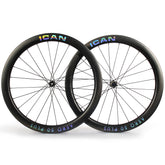How do I set up a tubeless race car?
The production of racing bikes, gravel bikes or cyclocross bikes is currently frequently mentioned in the media. It could easily be seen as a trend, but it makes riding more comfortable, and not having to change a tube in the rain is worth its weight in gold.
The other thing that comes with tubeless tires is that people worry about the setting. With road and gravel tires, we have found that installation is quicker and easier than with mountain bikes. It's definitely a lot easier than fat bikes.
A quick note about tire boosters: A lot of people use them to tighten mountain bike tires, but we haven't needed one on road bikes yet. If you remove the valve core and use a high quality track pump and pump quickly, you can add enough air to safely fill the tubeless tire.
tubeless road setting
There are two ways you can do this. You can use a completely new rim or an older wheel that you have been using and now want to upgrade. If you're using new wheels, you can do a little work.
If you have an older set of wheels, the first thing you need to do is remove the old rim tape.

You then need to clean the rim. Use an alcohol-based cleaner as it does not leave residue that can affect tubeless performance.

You should have a rim that looks nothing like the one pictured above.
If you are using new wheels, it should look similar right out of the box. You can also rub them with alcohol. If you use a carbon fiber rim, you should not use solvent.

Now you want to wrap the rim with tubeless tape. For a more cost-effective solution, you can also use Gorilla Tape.
Start the gluing process on the side of the rim opposite the valve hole. Pull the band taut and hold it in place. After a few centimeters the band should have enough grip to hold itself up. Work your way around the wheel.
The goal is to build up the center of the rim so that it is flat; once you achieve that, stop and cut the tape.

When you're finished taping, run a plastic tire lever over the edges to make sure they're tight. Also check for cracks or holes. If there are any, you will need to re-tape the wheels. Don't try to patch the tires because that will fail when you're miles away.
Make sure the valve is long enough to fit through the rim. Take a pick and pierce it far enough to create a small hole. Do this from the outside. You can also use a blade to do this, but this creates a larger hole that is harder to seal and allows air to escape.
Push the valve through the hole. This will give the hole just the right fit.

When you press the valve, the tape deforms, which is exactly what you want to achieve.
Take the locking ring and add a dab of grease. This will make life easier in the future. Then use the lock ring and tighten it.

Now comes the hardest part: mounting the tire. Tubeless tires and rims fit tightly together, and that can lead to some moments where you wish you hadn't started. Try using grippy gloves and good technique rather than tire levers.
If you must use a set of tire levers, get a plastic set. Even if there is no hose, you should be careful. You could accidentally lift the tubeless band.
Once the tire is on, massage it around the wheel so that it sits evenly on the wheel.
Now remove the valve core and put it in a safe place. Take your air pump and start pumping. You should hear a few pops as the tire comes into position. These noises are nothing to worry about; in fact, they should make you happy. Make sure the tire is seated all the way around.
Take the pump and remove it from the valve. All the air will escape, but that's okay.
Now take your sealant and pour the correct amount into your valve according to the manufacturer's instructions. There is an easy way to do this. Hold the valve on top of the wheel and connect the bottle of sealant to the valve, which usually has a small funnel.
Then turn the wheel over and the sealant will now flow out as little as possible.
Reinstall the valve core. Connect your pump and start pumping.
Inflate the tire and remove the pump.
Spin the wheel to coat the tire with the sealant. Knock him on the ground a few times to be sure.

Mount it on your bike and go for a short ride. The tire may slowly deflate a few times until the tire and rim are coated and sealed. So don’t set up your road bike tubeless the day before a big ride. Do it a week before the ride, and make sure everything is working before you go out for your big ride, this tip works for all bike parts and not just going tubeless.
On the road
It is possible for C02 cartridges to freeze the sealant, you may have read about this on a forum. The reason for this is that the release of the gas from a canister triggers an endothermic reaction.
In plain language, this means that the expansion of the gas absorbs all of the local heat. This is why cartridges freeze. This reaction can freeze the sealant, but there is an easy way to avoid this. Set your valve to the 12 o'clock position. Give the sealant a minute to get to the bottom of the tire and inflate. Then the temperature shock for the sealant should be lower.





